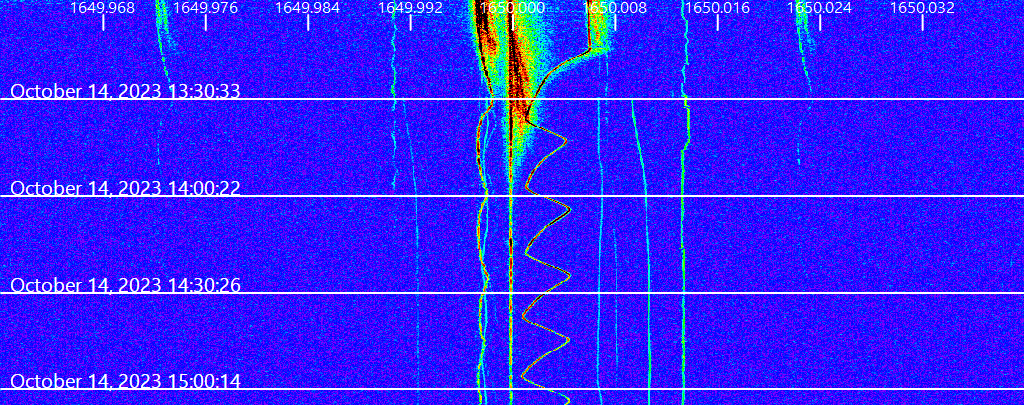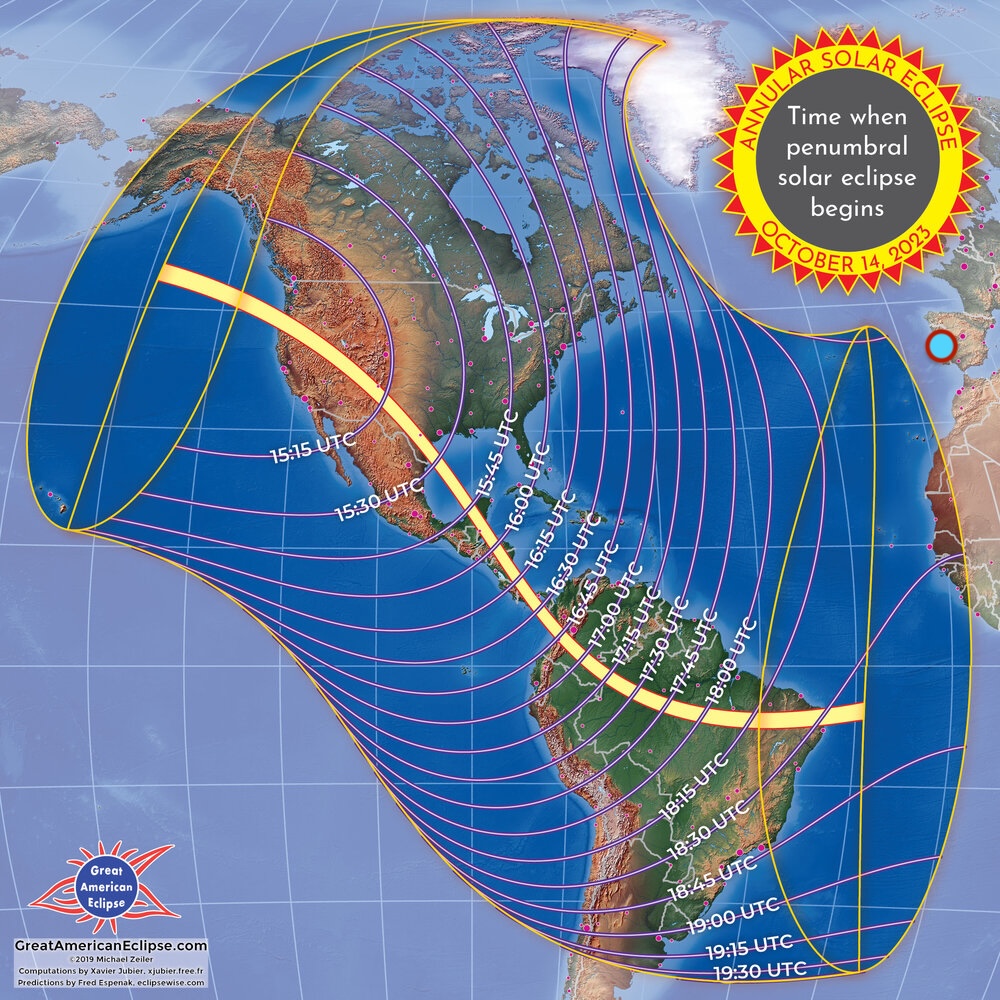MW Recordings - 2023 Eclipse - FoEIS
10 TerraBytes of MW Spectrum Recordings - Made During the October, 2023 Annular Eclipse
By Nick Hall-Patch, VE7DXR
During the October 14, 2023 annular solar eclipse across the Americas, 13 HamSCI volunteers recorded the entire medium wave AM broadcast band (525-1705 kHz ) at 14 sites in Canada, the USA, Mexico and Portugal, using software defined radios (SDRs). In addition, many participants made reference recordings of local sunrise and sunset periods on the day of the eclipse, as well as of the eclipse period on another day.
A variety of SDRs were used, with most using network time protocol to establish accurate Universal Time on the computers recording the SDR data. Some SDRs were locked to a frequency standard, while others recorded SDR files that included a frequency standard’s carrier.
The data sets have been uploaded to, and thoroughly indexed on, the free and open data repository, Zenodo.org: 2023 Eclipse MW Recordings. It is available for anyone who cares to examine the recordings, whether for research purposes or satisfaction of an individual's curiosity. Note: If the data is used for research, cited in an article, paper, poster or presentation, the participants would expect and appreciate the courtesy of receiving credit for their work. Questions regarding attribution should be directed to HamSCI, via e-mail.
Well over 10TB of SDR data was recorded by these participants, so some form of “first look” visualization of the data was required, as, for each participant, there were 117 domestic broadcast channels to be examined, spaced at 10kHz intervals across the medium wave band. This capability was provided by Carrier Sleuth software, which was used to process all the raw data, providing the ability to pinpoint AM broadcasters’ carrier frequencies in 80Hz wide waterfall displays of each channel in the medium wave band. An example for the broadcast channel on 1650kHz, is shown in Figure 1.

Figure 1
These visualization files, with an extension of FFT, require Carrier Sleuth software to open them. The latest version of the software can be obtained from Black Cat Systems, but a copy of it “CarrierSleuthWindowsMay2024.zip” is also provided in the Zenodo data set, courtesy of its developer, Chris Smolinski, W3HFU.
If desired, the user can obtain the raw data and re-examine it with Carrier Sleuth. For example, with further processing, evidence of 9kHz spaced carriers from East Asian transmitters can be seen in a couple of the west coast data sets. The software is also able to deliver CSV files of signal strength vs. time for a 0.1Hz slice of spectrum, which can allow the user to start processing specific parts of the data in earnest. Details about the use of Carrier Sleuth can be found in the “CarrierSleuthOverview.pdf” file included at this site.
From the initial processing, at least 400 distinct enhancements in broadcaster signal strengths of 10dB or greater were observed in the raw data sets during the eclipse period. Those data sets are identified on the Zenodo site referenced above, along with instructions for obtaining the raw data. In the best examples of enhancements, audio from the broadcaster can be heard along with the carrier. Some of these audio signals have already been identified by participants, but there are likely others still to be found, either by listening for station identification, or by comparing that audio with what was heard in recordings from other participants.
Eclipse participants and their data sets
The 14 October 2023 annular solar eclipse took place across North and South America (Figure 2). Almost all participants were in North America, but one, Carlos, CT7AUS, was just beyond the eclipse path, in Portugal, and searched for evidence of signals from the Americas fading in early at his location due to the eclipse-caused early darkness path across the Atlantic Ocean on 14 October.

Figure 2
Carlos did note early signal enhancements on the 14th compared with the 13th and 15th of October, but the effect was subtle. His location is indicated in Figure 2 by a pale blue circle.
Figure 3 shows the participants in North America, again indicated by the pale blue circles. Not all participants noted obvious effects from the eclipse in their data; that is noted in the Zenodo data sets, along with their Carrier Sleuth files and raw data available for their entire recording periods.
Figure 3
2023 MW Recordings were made by the following individuals. Details on their equipment (receiver, antennas, software). locations, positions relative to the October 14, 2023 annular solar eclipse, can all be found on the Zenodo site referenced above.
| Name | Call Sign | Maidenhead Grid Square |
|
Carlos Nascimento |
CT7AUS | IM58ht |
|
Burke Baumann |
KF7NP | DM33wp |
|
Nick Hall-Patch |
VE7DXR | CO44aa and CN88ik |
|
Richard Cook |
K6EEE | CM98jp |
|
Nigel Pimblett |
VE6TNF | DN49rx |
|
Mark Whittington |
AG5RT | EL19et |
|
Manuel F. Caballero |
XE2NNS |
DL59vp |
|
James Niven |
(none) | EM10fc |
|
Mike Boice |
KW1ND | EM75wx |
|
Tim Tromp |
KE8JFM | EN63we |
|
Bill Whitacre |
(none) | FM18kt |
|
John Glover |
W2QL | FM18iu |
|
John Ciccoletta |
N3BE | FN12oh |
